Tiny Red Bugs on Plants (With Pictures) – Identification and Control
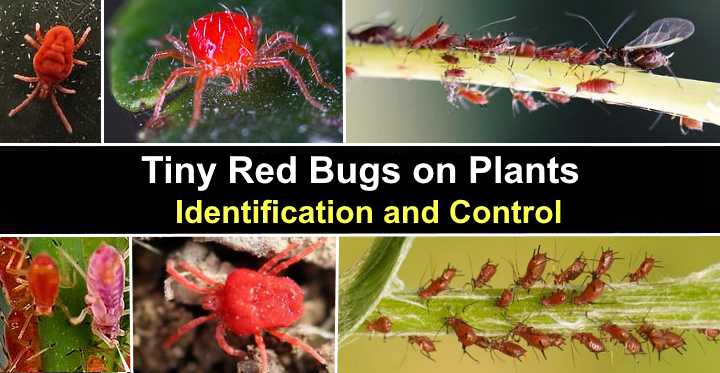
Discovering tiny red bugs on plants can signify a bug infestation. Red plant bugs like clover mites and spider mites can be so tiny they are difficult to spot with the naked eye. However, the minuscule, red-bodied mites can be so numerous that they look like pepper on the underside of leaves. While the red bugs won’t kill plants, they can weaken plant growth and cause leaf discoloration.
Spider mites and clover mites are not the only tiny red bugs that can infest houseplants or ornamental garden shrubs. Other small red bugs can be chiggers or red aphids. Although chiggers won’t destroy landscaping plants, they can give you a nasty, itchy bite.
This article is a guide to identifying tiny red bugs you may find on plants. In addition to descriptions and pictures of the small red creatures, you’ll find helpful tips on getting rid of the nasty bugs.
Red Bugs on Plants That Look Like Little Red Spiders
Have you noticed tiny red insect-like creatures with a round or pear-shaped red body and eight legs? If so, these tiny red bugs are probably red spider mites or clover mites. The little bugs are related to spiders in the class Arachnida. They have eight legs and an oval, reddish-brown body.
Identifying bugs that look like tiny red spiders is challenging due to their minute size. It usually requires examining plant leaves under a magnifying lens to spot their eight legs, round body, and other identifying features. This can make it challenging to tell clover mites apart from spider mites.
Although red spider mites and clover mites are referred to as bugs, they are not bugs in the botanical sense. Scientifically, bugs are sap-sucking insects in the order Hemiptera. Like most insects, true bugs only have six legs and jaw parts that the bugs use to bite into plant tissue.
On the other hand, mites are not classified as insects as they have eight legs and don’t have antennae or wings. However, because clover mites and spider mites are common plant pests, we will also refer to them as bugs in this article.
Clover Mites on Plants (Bryobia praetiosa)

A close up picture of a red clover mite
Clover mites are plant-feeding pesky creatures with reddish-brown oval bodies and eight legs. An identifying feature of red clover mites is their two long front legs that look like antennae. Clover mites measure 0.03” to 0.033” (0.75 – 0.85 mm). You generally find them on grass, but they can venture indoors in spring.
The life cycle of clover mites starts as a tiny bright red egg, usually laid in clusters of several eggs. The clover mite larva is also bright red and has a disc-shaped body and six legs. As the tiny red bug grows, it develops two more legs.
Adult clover mites have a reddish-brown to dark greenish-brown color. They tend to feed on turfgrass, ornamental flowers, impatiens, dandelions, and daffodils. Typically, the tiny red creatures don’t significantly damage plants in the yard.
However, red clover mites can cause damage in gardens if their population increases. You may notice signs of clover mite damage as large brown patches in lawns. Or the red mite plant damage can result in wilting foliage that turns yellow or brown.
Clover mites can become a nuisance in homes in spring after heavy rains or when the weather turns cooler. The annoying red bugs look like tiny dark red spots moving around windows, doors, and walls. Although the red pests don’t bite, feed on fabric, or transmit diseases, they leave behind red stains when crushed.
The good news with these irritating creatures is that the red stains aren’t because they suck blood. Instead, it’s due to the red pigments their body fluids contain. However, this can make it easy to confuse infestations of clover mites with bed bugs or other blood-sucking insects.
Tiny red bug identification
Clover mites are identified as reddish-brown creatures with an oval body and eight legs. A characteristic trait of the red mites is their two extended front legs which help distinguish them from other mites. Indoors, the tiny reddish bugs look like dark pepper marks moving over walls.
Because clover mites are so tiny, identifying them indoors can be challenging. Therefore, if you notice little reddish-black dots on walls or near windows, crush a few. You can quickly identify the mites if they leave behind a red stain.
How to prevent clover mites in the home
The best way to prevent clover mites from invading your home is to avoid having shrubs, plants, or lawn grass too close to the foundation. Keeping a 2-foot (60 cm) gap between vegetation and the building deters the tiny mite from venturing further.
To increase the barrier’s effectiveness, you can put a layer of pea gravel around the foundation line. If you decide to have foundation shrubs near your home, try to ensure that the branches and foliage don’t touch the building.
Another way to prevent clover mites is to avoid over-fertilizing your lawn. Too much nitrogen in turfgrass can cause populations of clover mites to increase. Additionally, mow your lawn to the ideal height of 3” to 4” (7.5 – 10 cm).
How to get rid of clover mites
Clover mites are challenging to eradicate because they leave behind annoying red stains if you squish them.
Therefore, the best method of killing the pests is to use a vacuum cleaner. Vacuum all areas where you have spotted clover mite activity. Then seal the dust bag in a plastic bag and put it in the trash to prevent a further infestation.
If you discover clover mites crawling on the side of your house, you can wash them off with a hose to stop them from entering your home.
Tiny Red Spider Mites (Tetranychus urticae)

Red spider mites on a leaf underside
Red spider mites are plant-feeding pests with red or orange oval bodies and eight translucent legs. Like clover mites, spider mites are too tiny to identify with the naked eye. However, under a microscope, you’ll see they have an oval body and eight spiny legs.
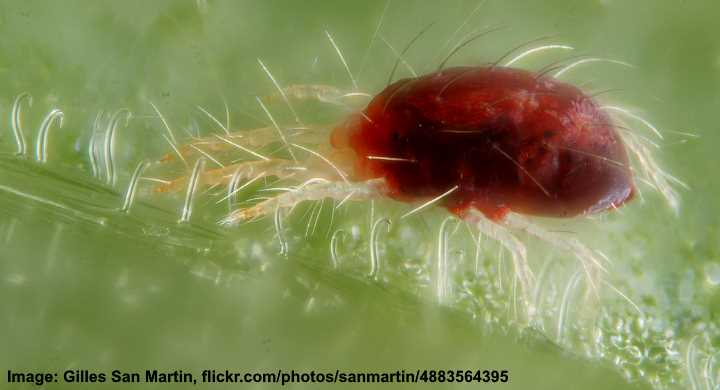
A close up picture of a red spider mite
These tiny orangey-red spider mites measure around 0.0015” (0.4 mm), and they have an elliptical body with spines on their backs.
Because of their minute size, red spider mites are almost impossible to see. The most obvious signs of the red bugs on plants are tell-tale webbing or string-like silky strands dangling from leaves. However, a large infestation of red spider mites may look like clusters of tiny red dots under plant foliage.
A red spider mite’s life cycle starts as a tiny egg attached to webbing between leaves and stems. After hatching, the larvae quickly develop into adults and start feeding on plant tissue.
Red spider mites bite into plant tissue with their piercing mouthparts and then suck sap from plants. Spider mite plant damage can cause leaves to turn yellow or brown, and flower petals may wither. A severe red spider mite infestation can result in complete plant defoliation.
Red spider mites thrive in hot, dry, dusty conditions. On ornamental plants and shrubs, spider mites are common during summer and fall, especially if there is little rainfall. Because they are so tiny, large populations can develop before you realize you have a problem.
Infestations of red spider mites also occur on houseplants. The pesky red bugs get into the house if you buy infested plants from the garden center. Additionally, houseplants that are kept outdoors during the summer could develop problems with spider mites. Therefore, always inspect plants when you bring them indoors.
One way to identify red spider mites on houseplants is to put a sheet of white paper under the leaves. Then gently tap on the foliage and stems to see if any bugs drop. You can also thoroughly inspect the underside of leaves for signs of characteristic red spider mite webbing.
Tiny red bug identification
You can identify red spider mites using a 10x or 15x magnifying lens. To do this, inspect plant foliage for tiny orange-red creatures with oval bodies. The red bugs also have translucent legs and soft setae covering their back and legs.
However, their distinctive webbing is the easiest way to identify red spider mites. Look for the strands of silky webbing on plant foliage that the little red arthropods spin. If numbers are large, you will notice clusters of tiny red dots that look like pinpricks.
How to prevent red spider mites in the home
The best way to avoid an infestation of red spider mites is to prevent them from getting into your home. Therefore, always be in the habit of inspecting new houseplants thoroughly for signs of spider mite activity. It’s also a good idea to wipe leaves regularly or spray plants.
Red spider mites thrive in dry conditions. Therefore, keeping houseplants properly watered and ensuring adequate humidity for plants can help prevent the tiny red bugs from becoming a significant problem.
How to get rid of red spider mites
Suppose you notice identifying signs of red spider mite activity. In that case, acting without delay is crucial to rid your ornamental shrubs and houseplants of plant-destroying pests. Here are some tips on getting rid of red spider mites for good.
To get rid of red spider mites on outdoor plants, spray the shrub foliage with sharp blasts of water from the garden hose. This should be enough to dislodge them. If the infestation appears significantly large, you could prune and destroy the affected stems and branches.
To eliminate red bugs from indoor plants, use a homemade neem oil spray. Mix 2 tsp. organic neem oil and 1 tsp. liquid Castile soap with a quart (1 l) of warm water in a spray bottle. Shake well, and liberally spay your houseplant foliage to get rid of all types of bugs for good. Apply every seven days for best results.
Related reading: How to kill red spider mites on plants.
Small Red Bugs on Plants
Besides clover mites and red spider mites on plants, other kinds of tiny red pests could be chiggers or red aphids. Here is helpful information on identifying other red bugs on your plants.
Chiggers (Trombicula)
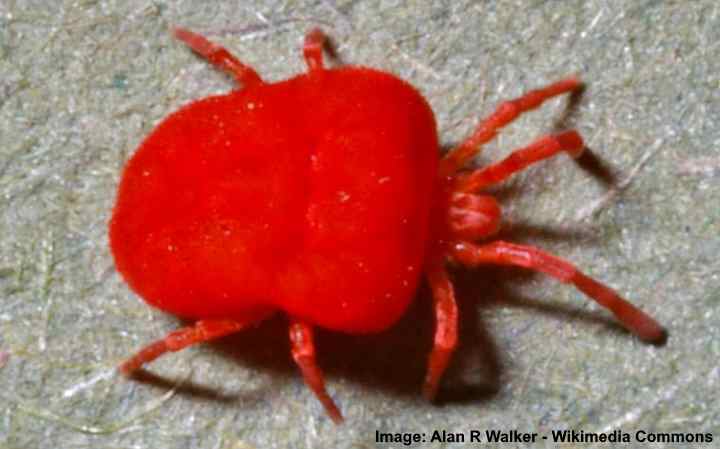
A close up image of a berry bug / chigger (Trombicula autumnalis)
Chiggers are tiny red arachnids with deep red pear-shaped bodies and eight legs. The red mites are so small they are described as microscopic and only measure 0.016” (0.4 mm). Like many kinds of mites, the tiny red creatures have two protruding front legs that look like antennae.
Adult chiggers are typically found in damp grasslands and forested areas. However, they may feed on weeds, low-growing ornamental plants, and other vegetation.
Adult chiggers are rarely bothersome to humans. But it’s chigger larvae that cause pimple-like bumps, hives, and itchy skin rashes. Red chigger larvae don’t bite humans. Instead, they form a hole in the skin by injecting digestive enzymes. They then chew on the inner skin, causing severe itching and sometimes pain.
Tiny red bug identification
Under the microscope, chiggers look like red tear-shaped bugs, sometimes with dark patterns on their back. They have smooth bodies and eight segmented legs. Without aid, chiggers are incredibly difficult to spot.
How to get rid of chiggers
The best way to eliminate chiggers is to create unfavorable conditions in your yard. Chiggers thrive in long grassy areas that are constantly moist. Therefore, keeping grass relatively short and removing weeds can help prevent them from multiplying.
To prevent chigger bites, it’s best to use an insect repellant and wear long clothing. This will also prevent you from getting ticks or other nasty insect bites.
Tiny Red Aphids on Plants (Aphidoidea)
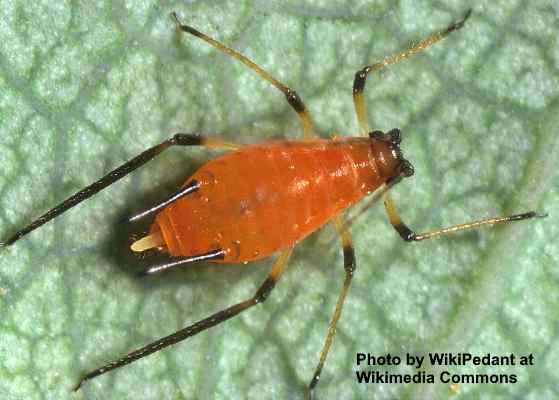
A close up picture of red aphid on a leaf
Red aphids are tiny red bugs with six legs and piercing jaws they use to suck sap from plants. The little orange-red pear-shaped bugs have black and yellowish legs, two antennae, and two short protrusions at their rear end. The small, red soft-bodied insects grow 0.78” to 0.15” (2 to 4 mm) long.
Unlike spider mites, clover mites, and chiggers, red aphids are a true type of bug in the order Hemiptera. You will often find the destructive tiny red pests on the underside of leaves, where they feed on the juice of soft plant tissue.
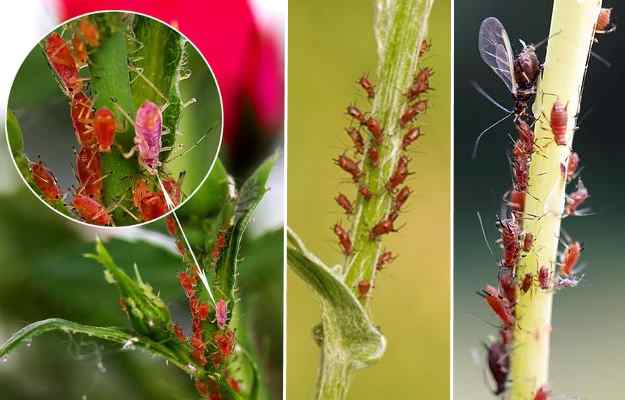
Red aphids on plants
Unfortunately, red aphids can cause tremendous plant damage. Aphid activity on plants can result in stunted growth, yellowing foliage, and wilting leaves. In some cases, a red aphid infestation can kill plants. In addition, the sap-sucking nature of aphids weakens plant growth, making plants more susceptible to disease.
Another issue caused by red aphids is the honeydew they secrete. This can cause secondary plant damage, including fungal infections and black sooty mold.
Tiny red bug identification
Red aphids are identified by their orangey-red bodies, black and yellow legs, and two stumpy protrusions at their rear. Aphids are so tiny that they are most noticeable when in groups. Identifying signs of aphid plant damage are poor growth and yellow, wilting foliage.
How to get rid of red aphids
Eliminating red aphids for good is challenging because they breed rapidly. Therefore, using a multi-system approach is vital to disrupt their life cycle and prevent them from breeding. Here are some ideas on how to kill aphids from outdoor plants and houseplants.
To get rid of red aphids from garden plants, use the garden hose to blast them from foliage. Then, try to rinse the shrubs, trees, and ornamental plants every few days to keep an infestation at bay. Similarly, you could rinse houseplants under the shower to remove them from foliage.
To eradicate red aphids from houseplants, try using a homemade soap spray. To make the aphid soap spray, fill a 1-quart (1 l) spray bottle with water and add two teaspoons of liquid Castile soap. Spray the soapy solution liberally on foliage and wipe with a soft sponge.
Alternatively, you could also kill red aphids using a neem oil spray or wiping plant leaves with a diluted rubbing alcohol solution.
Related articles:
